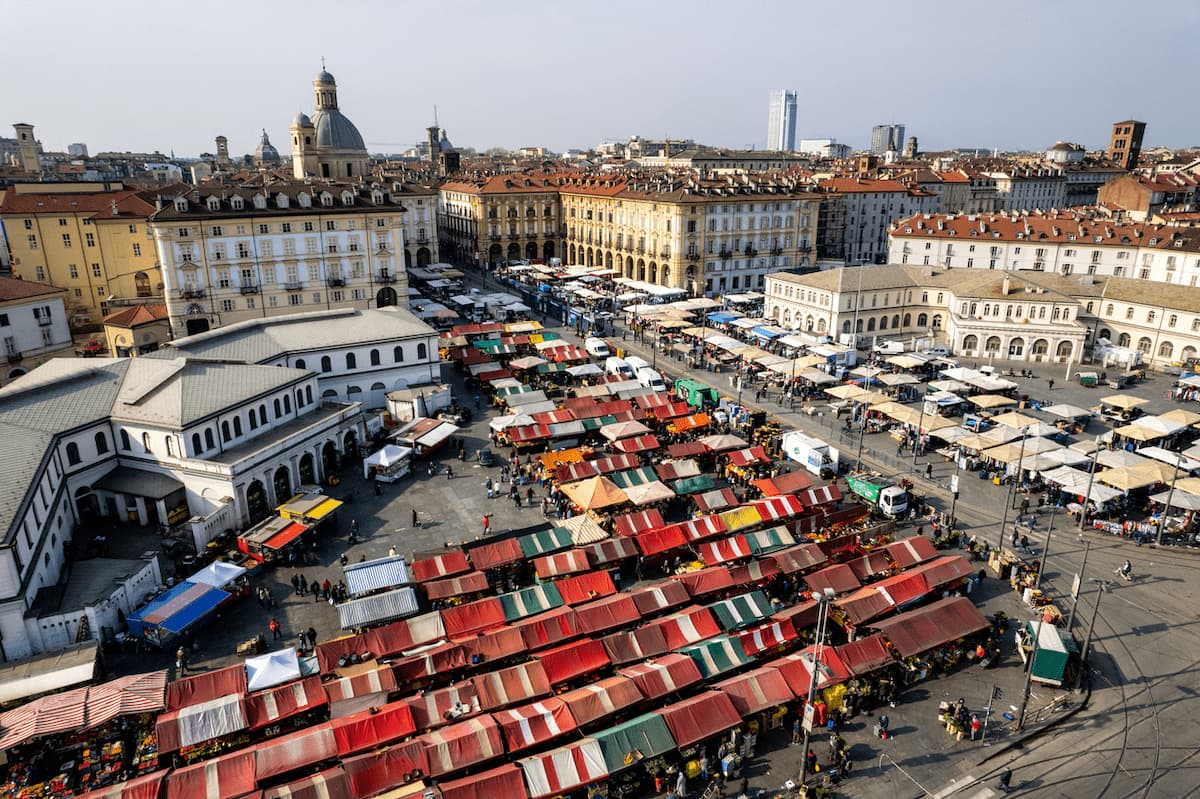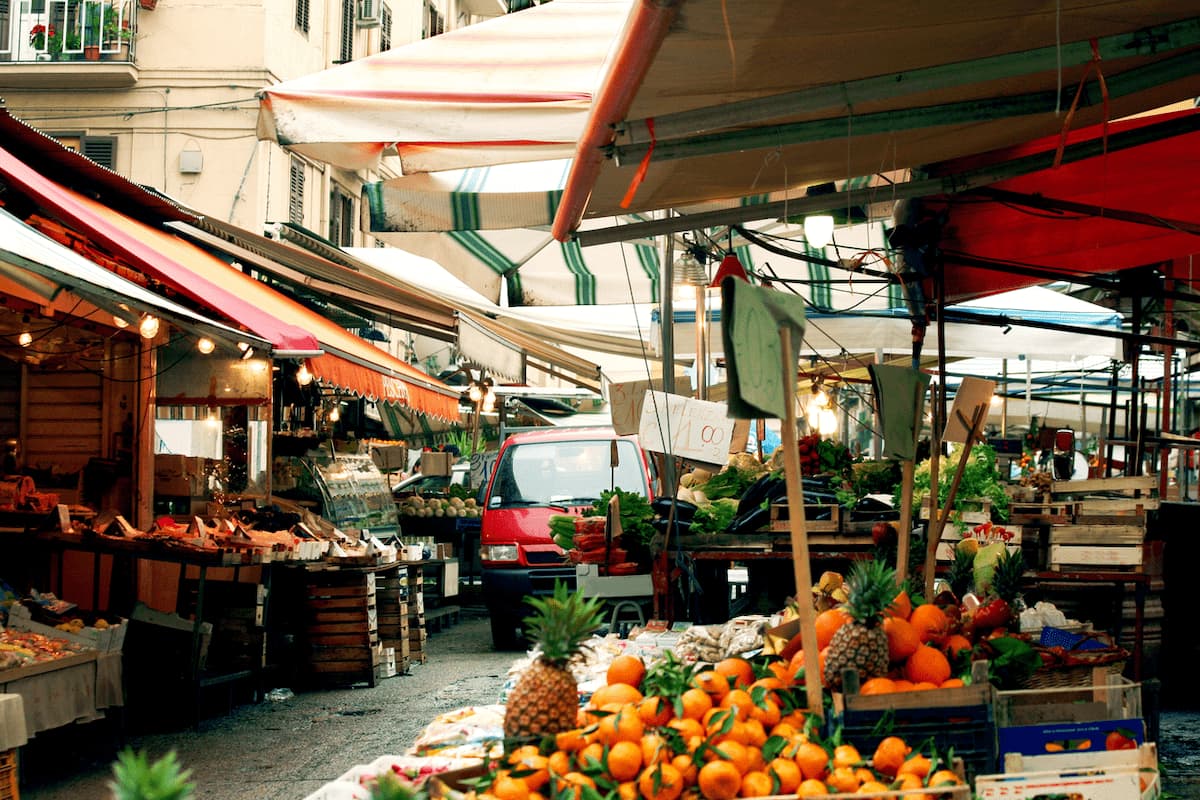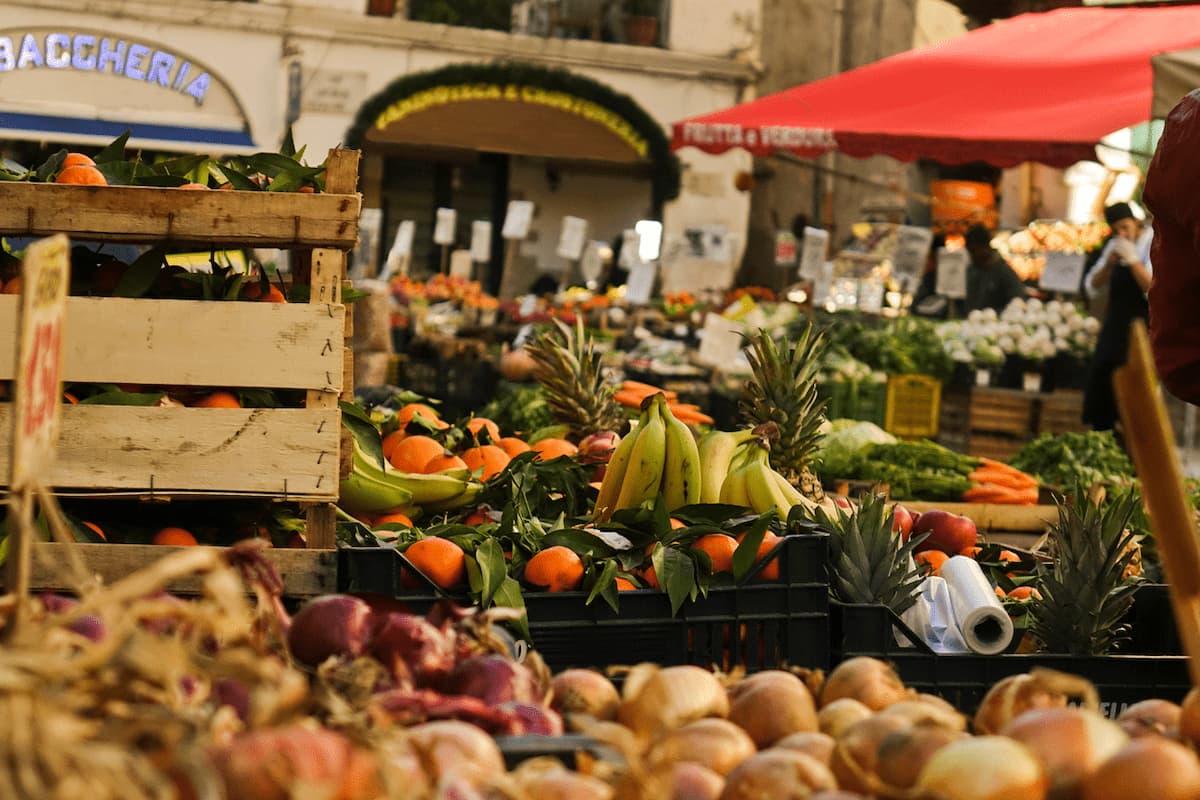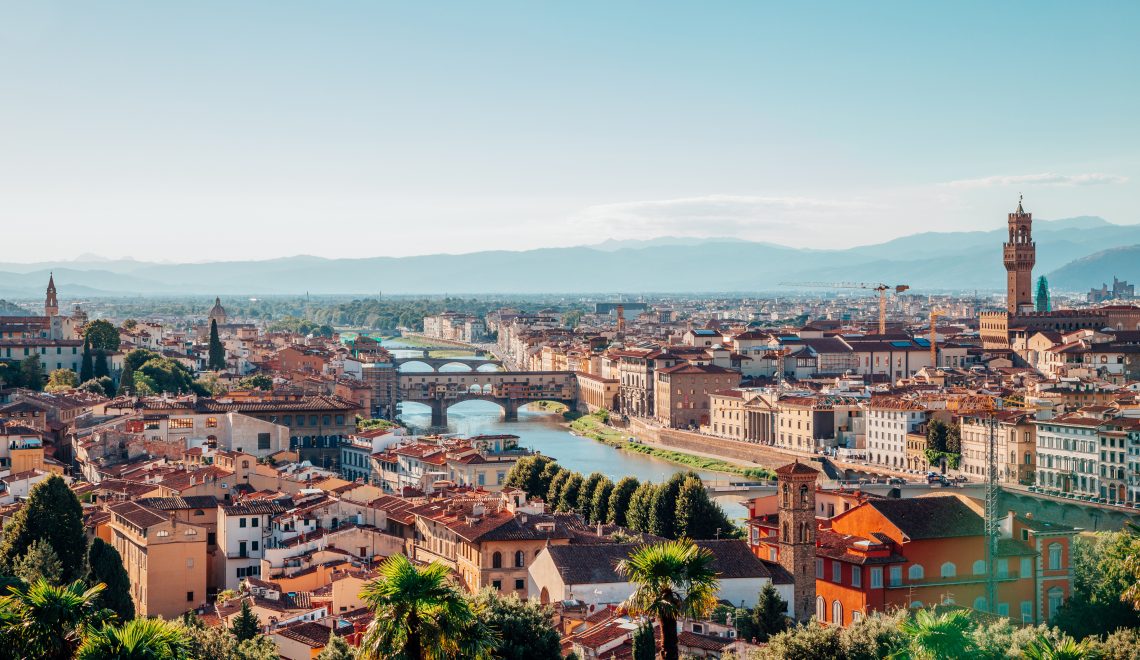
Italy’s food markets are not just places to shop; they are cultural experiences that reflect the country’s rich culinary traditions. Each market offers unique insights into local life while showcasing regional ingredients that form the backbone of Italian cuisine.
- What to Buy: Must-Have Ingredients at Italian Food Markets
- The biggest Italian Food Markets
- Mercato Centrale e Mercato di Sant’Ambrogio, Florence
- Mercato di Porta Palazzo, Turin
- Mercato di Testaccio, Rome
- Mercato di Rialto, Venice
- Ballarò Market, Palermo
- Mercato di Mezzo, Bologna
- Mercato Albinelli, Modena
- Mercato Pignasecca, Naples
What to Buy: Must-Have Ingredients at Italian Food Markets
Italian food markets offer a sensory experience like no other. The vibrant colours, the tantalising aromas and the friendly chatter of vendors create a truly authentic atmosphere. Here are some must-have ingredients you’ll want to look out for:
Fresh Produce: Seasonal Fruits and Vegetables You Can’t Miss
Italy is a land of abundance, and its food markets reflect this. From juicy tomatoes and plump olives to fragrant herbs and seasonal fruits, you’ll find a wide variety of fresh produce. Be sure to try local specialties like puntarelle (chicory) in Rome or friarielli (broccoli rabe) in Naples.
Artisan Cheeses: from Parmigiano-Reggiano to Burrata
Italy is renowned for its cheese, and its food markets are the best place to sample a variety of regional specialties. From the hard, granular Parmigiano-Reggiano to the creamy, mozzarella-like burrata, there’s a cheese to suit every palate.

Cured Meats: Prosciutto, Salami and Local Specialties
Cured meats are a staple of the Italian diet, and you’ll find a wide selection at food markets. Prosciutto from Parma and salami from Milan are just two of the famous varieties. Don’t forget to try local specialties like soppressata from Calabria or speck from the Alto Adige.
Olive Oil, Vinegar and Spices: Bringing Italian Flavour Home
High-quality olive oil, balsamic vinegar and a variety of herbs and spices are essential for recreating Italian flavours at home. Visit a local producer to learn about the different varieties and find the perfect one to suit your taste.
The biggest Italian Food Markets
Italy boasts numerous food markets that are not only popular with locals but also attract visitors from around the world. Here are some of the largest and most renowned:
1. Mercato Centrale e Mercato di Sant’Ambrogio, Florence
Florence’s Mercato Centrale is a bustling hub where you can find everything from fresh produce to gourmet street food. Located in the heart of Florence, the Mercato Centrale is situated at Piazza del Mercato Centrale. This vibrant market is housed in a stunning 19th-century building and features a variety of stalls selling fresh produce, meat, cheese and local delicacies.

The upper floor has been transformed into a gourmet food hall with numerous eateries offering a range of delicious dishes, making it a perfect spot for food lovers to sample the best of Tuscan cuisine.
The nearby Mercato di Sant’Ambrogio can be found at Piazza Lorenzo Ghiberti, just a short walk from the city centre. This market offers a more traditional market experience with local vendors selling seasonal fruit, vegetables and artisanal products. It’s an excellent place to experience the local culture and pick up some authentic Tuscan ingredients.
2. Mercato di Porta Palazzo, Turin
As one of Europe’s largest open-air markets, Porta Palazzo in Turin is a real treasure trove of wonderful things! Spanning several blocks, this vibrant market features an eclectic mix of stalls selling everything from fresh produce to exotic spices.

Piazza della Repubblica is another jewel! You’ll find everything from the freshest fish to the most colourful fruit and vegetables, all alongside local delicacies such as truffles and hazelnuts.
The market is particularly famous for its diversity; it reflects Turin’s multicultural population with vendors offering products from various regions and countries.
3. Mercato di Testaccio, Rome
Located in the historic Testaccio neighbourhood, this market is known for its focus on traditional Roman dishes and local produce. The market has been renovated to modernise its offerings while retaining its authentic character.
It is particularly popular among locals and food enthusiasts looking to experience traditional Roman cuisine and ingredients. The market features numerous stalls where vendors sell seasonal fruit and vegetables, as well as prepared foods that showcase the rich culinary heritage of the region.
4. Mercato di Rialto, Venice
The Rialto Market has been Venice’s main market since the 11th century. The Mercato di Rialto is located in Venice, Italy, specifically at Campo della Pescaria.

Situated near the iconic Rialto Bridge, this market is famous for its fresh seafood, which plays a crucial role in Venetian cuisine. Early risers can witness fishermen bringing in their daily catch as vendors display an impressive selection of fish and shellfish.
Aside from seafood, the market also offers fresh fruit and vegetables sourced from local farms. A stroll through this bustling market provides not only an opportunity to purchase quality ingredients but also a chance to soak up the unique atmosphere of Venice.
Ballarò Market, Palermo
In Palermo, Ballarò Market is a lively place filled with colourful stalls selling everything from herbs and spices to street food. It’s an excellent spot to experience Sicilian culinary traditions firsthand while enjoying local delicacies like arancini (stuffed rice balls).

The market is not just about food; it also serves as a social hub where locals gather to chat and barter. The vibrant colours and sounds create an unforgettable experience that encapsulates the essence of Palermo.
Mercato di San Lorenzo, Milan
The Mercato di Mezzo in Bologna is a historic food market that dates back to the Middle Ages, making it one of the oldest markets in the city. Located in the central Quadrilatero district, it sits between two significant squares: Piazza Maggiore and Piazza di Porta Ravegnana, which is why it is referred to as “di Mezzo” (meaning “in the middle”).
The market is open seven days a week from 10 AM until midnight, making it accessible for both daytime shopping and evening dining experiences. Regular events such as tastings and cultural gatherings are also held, further enriching the experience for visitors.
The Mercato di Mezzo spans three levels, featuring a variety of stalls and shops where visitors can purchase or enjoy local delicacies. It offers an array of products including:
- Local meats and cheeses: Famous for its cured meats and cheeses from the Emilia-Romagna region.
- Fresh pasta: Including the renowned tortellini, a staple of Bolognese cuisine.
- Fruits and vegetables: Seasonal produce sourced from local farms.
- Fine wines: A selection of regional wines, including organic options.
Visitors can also find small eateries and bars serving traditional dishes, street food, and craft beers.
Mercato Albinelli, Modena
In Modena, Mercato Albinelli stands out as an elegant indoor market that combines tradition with modernity. Known for its high-quality products, this market offers a selection of local specialties such as balsamic vinegar and handmade pasta.

The beautifully restored building provides a charming setting where visitors can browse through various stalls offering fresh produce, meat, cheese and baked goods. It’s the perfect spot for those looking to experience Modena’s culinary heritage firsthand.
Mercato Pignasecca, Naples
Finally, Mercato Pignasecca in Naples is renowned for its lively atmosphere and extensive selection of local foods. It is located in the historical quarter of Naples, Quartieri Spagnoli, not far from the city centre.

This bustling market offers everything from fresh seafood to traditional Neapolitan pastries like sfogliatella.
Pignasecca is particularly famous for its street food scene; visitors can enjoy local favourites such as pizza fritta (fried pizza) while exploring the vibrant stalls filled with colourful produce and regional delicacies.
For those eager to explore Italy’s gastronomic treasures, Italo provides convenient travel solutions to reach major Italian cities at high-speed. Whether you’re hopping on a bullet train to Florence or to Venice, your journey through Italy’s culinary landscape awaits.







